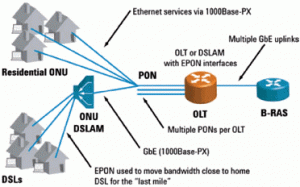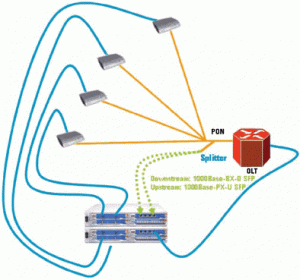The EPON system consists of multiple optical network units (ONU), an optical line terminal (OLT), and one or more optical networks (see Figure 1). In the extension direction, the signal sent by the OLT is broadcast to all ONUs. 8h Modify the frame format, redefine the front part, and add the time and logical identification (LLID)). The LLID identifies each ONU in the PON system, and the LLID is specified during the discovery process.

(1) Ranging
In the EPON system, the physical distance between each ONU and the OLT in the upstream information transmission direction is not equal. The general EPON system stipulates that the longest distance between ONU and OLT is 20km, and the shortest distance is 0km. This distance difference will cause the delay to vary between 0 and 200 us. If there is not enough isolation gap, signals from different ONUs may reach the receiving end of the OLT at the same time, which will cause conflicts of upstream signals. The conflict will cause a large number of errors and synchronization loss, etc., causing the system to fail to work normally. Using the ranging method, first measure the physical distance, and then adjust all the ONUs to the same logical distance as the OLT, and then perform the TDMA method to achieve conflict avoidance. At present, the ranging methods used include spread-spectrum ranging, out-of-band ranging and in-band window-opening ranging. For example, the time tag ranging method is used to first measure the signal loop delay time from each ONU to the OLT, and then insert a specific equalization delay Td value for each ONU, so that the loop delay time of all ONUs after inserting Td ( Called equalization loop delay value Tequ) are equal, the result is similar to that each ONU is moved to the same logical distance as the OLT, and then the frame can be sent correctly according to the TDMA technology without conflict. .
(2) Discovery process
The OLT finds that the ONU in the PON system sends Gate MPCP messages periodically. Upon receiving the Gate message, the unregistered ONU will wait a random time (to avoid simultaneous registration of multiple ONUs), and then send a Register message to the OLT. After successful registration, the OLT assigns an LLID to the ONU.
(3) Ethernet OAM
After the ONU has registered with the OLT, the Ethernet OAM on the ONU starts the discovery process and establishes a connection with the OLT. Ethernet OAM is used on ONU/OLT links to find remote errors, trigger remote loopbacks, and detect link quality. However, Ethernet OAM provides support for customized OAM PDUs, information units and time reports. Many ONU/OLT manufacturers use OAM extensions to set special functions of ONUs. A typical application is to control the bandwidth of end users with the configuration bandwidth model expanded in the ONU. This non-standard application is the key to the test and becomes an obstacle to the intercommunication between ONU and OLT.
(4) Downstream flow
When the OLT has traffic to send the ONU, it will carry the LLID information of the destination ONU in the traffic. Because of the broadcasting characteristics of PON, the data sent by the OLT will be broadcast to all ONUs. We must especially consider the situation where downstream traffic transmits video service streams. Due to the broadcast nature of the EPON system, when a user customizes a video program, it will be broadcast to all users, which consumes downstream bandwidth very much. OLT usually supports IGMP Snooping. It can snoop IGMP Join Request messages and send multicast data to users related to this group instead of broadcasting to all users, reducing traffic in this way.
(5) Upstream flow
Only one ONU can send traffic at a certain time. The ONU has multiple priority queues (each queue corresponds to a QoS level. The ONU sends a Report message to the OLT to request a sending opportunity, detailing the situation of each queue. The OLT sends a Gate message in response to the ONU, telling the ONU the start time of the next transmission The OLT must be able to manage the bandwidth requirements for all ONUs, and must prioritize the transmission permission. According to the priority of the queue and balance the requests of multiple ONUs, the OLT must be able to manage bandwidth requirements for all ONUs. Dynamic allocation of upstream bandwidth (ie DBA algorithm).
2.2 According to the technical characteristics of the EPON system, the test challenges faced by the EPON system
(1) Considering the scale of EPON system
Although IEEE802.3ah does not define the maximum number in an EPON system, the maximum number supported by an EPON system is from 16 to 128. Each ONU joining the EPON system requires an MPCP session and OAM session. As more sites join EPON, the risk of system errors will increase. For example, each ONU needs to rediscover process, login process and start OAM session. Therefore, the recovery time of the entire system will increase with the number of ONUs.
(2) The problem of intercommunication of equipment
The following aspects are mainly considered for the intercommunication of equipment:
●The dynamic bandwidth algorithm (DBA) provided by different manufacturers is different.
●Some manufacturers use OAM’s “OrganizaTIon Specific Elements” to set specific behaviors.
●Whether the development of MPCP protocol is completely consistent.
●Whether the distance measurement methods developed by different manufacturers are consistent with the clock processing.
(3) Hidden dangers in the transmission of triple play services in the EPON system
Due to the transmission characteristics of EPON, some hidden dangers will be introduced when transmitting triple play services:
● Downstream wastes a lot of bandwidth: EPON system uses broadcast transmission mode in the downstream: each ONU will receive a large amount of traffic sent to other ONUs, wasting a lot of downstream bandwidth.
●The upstream delay is relatively large: When the ONU sends data to the OLT, it must wait for the transmission opportunity allocated by the OLT. Therefore, the ONU must buffer a large amount of upstream traffic, which will cause delay, jitter, and packet loss.
3 EPON test technology
The test of EPON mainly includes several aspects such as interoperability test, protocol test, system transmission performance test, service and function verification. The standard test topology is shown in Figure 2. IXIA’s IxN2X products provide a dedicated EPON test card, an EPON test interface, can capture and analyze MPCP and OAM protocols, can send EPON traffic, provide an automatic test program, and can help users test DBA algorithms.






